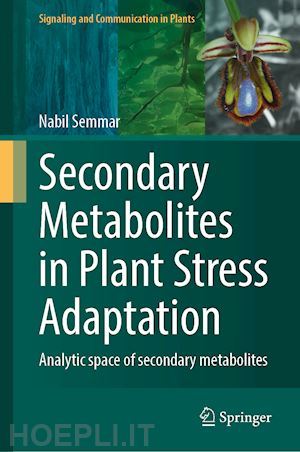
Questo prodotto usufruisce delle SPEDIZIONI GRATIS
selezionando l'opzione Corriere Veloce in fase di ordine.
Pagabile anche con Carta della cultura giovani e del merito, 18App Bonus Cultura e Carta del Docente
This book covers correlation and combined disciplinary aspects implying the use of secondary metabolites (SMs) of different plant species for control and monitoring of environment states. Phytochemical management of ecological systems represents an integrative field aiming for determination/evaluation of environment conditions from qualitative and quantitative analysis of plant metabolites. Plants respond to environmental conditions through productions of secondary metabolites. SMs represent highly variable and sensitive phytocompounds because of their small produced amounts, high structural variability and diversified activities. These characteristics make variations of SMs in plants to be highly informative on environmental conditions, physiological states and biological interactions. Qualitative and quantitative variations of SMs in plants are subject to correlation analyses to highlight links between biotic/abiotic conditions and plant chemical patterns.
Nabil Semmar has Ph.D. in phytochemistry with a multidisciplinary training pattern combining applied statistical analyses to different biological fields including environmental sciences (marine, terrestrial: bachelor degree), biotechnologies (master) and pharmacology (postdoctoral researches). In his Ph.D. (Lyon, 2000), he studied the flavonoids and saponins in the leaves and roots of Astragalus caprinus (Fabaceae). During his Ph.D., he developed a new simulation approach based on simplex rule (mass conservation law) helping for computational analysis of metabolic pathways and chemical polymorphism at population scale from HPLC data. Publication of this approach was followed by the invitation of N. Semmar by IAEA (Vienna, 2008) for conference and project discussion. Nabil Semmar carried out several correlation analyses between quantitative and qualitative aspects of secondary metabolites (as well as primary metabolites and drugs) leading to highlight mass distributionand metabolic regulation processes governing structural variability and sequential biosynthesis ways in plant matrices, pharmacological systems and environment.











Il sito utilizza cookie ed altri strumenti di tracciamento che raccolgono informazioni dal dispositivo dell’utente. Oltre ai cookie tecnici ed analitici aggregati, strettamente necessari per il funzionamento di questo sito web, previo consenso dell’utente possono essere installati cookie di profilazione e marketing e cookie dei social media. Cliccando su “Accetto tutti i cookie” saranno attivate tutte le categorie di cookie. Per accettare solo deterninate categorie di cookie, cliccare invece su “Impostazioni cookie”. Chiudendo il banner o continuando a navigare saranno installati solo cookie tecnici. Per maggiori dettagli, consultare la Cookie Policy.